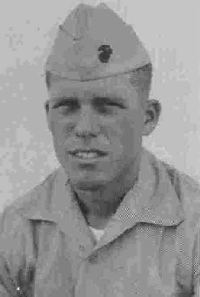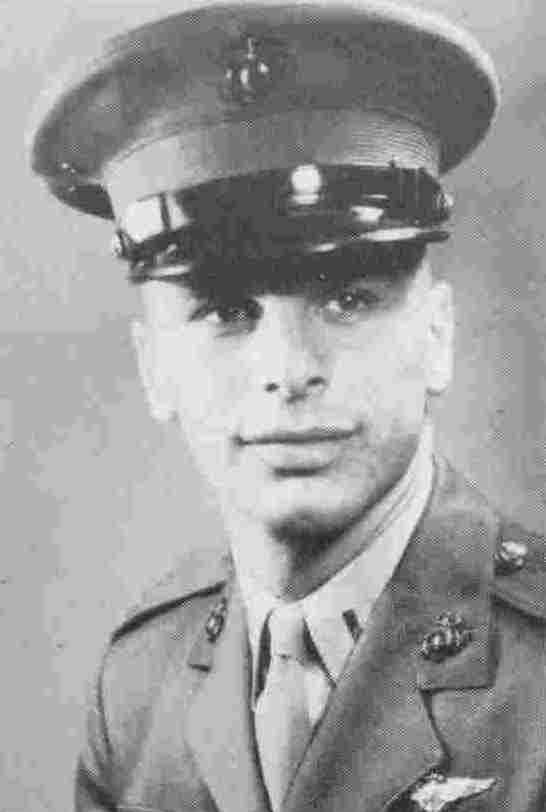and
CWO-3 Robert F. Patton's Silver Star
This emergency resupply mission
came late in the day 5 June 1964 as light was quickly fading and most of
the squadron's crew members had departed from the flight line. The Army
Special Forces advised the Squadron Duty Officer that one of their hilltop
outposts some twenty miles south of Da Nang had been surrounded and under
sustained attack for quite awhile and was running low on ammo. If they
didn't get a resupply they wouldn't make it through the night.

Two UH-34 (Dog) crews from Marines
still in the squadron area were quickly formed. The lead aircraft
piloted by CWO Bob Patton (his crew unknown) and the chase aircraft piloted
by 1stLt. Ron DeBrincat with Cpl. Warren F. Smith acting as the crew chief
and LCpl. Larry R. Henderson flying as the
gunner (the co-pilot is unknown). At the same time two Army
UH-1B (Hueys), of the 52nd Aviation Battalion better known as "Dragon Flight",
were being prepared to provide armed support of the mission. Another
name had been fondly given to the Army gun ships of "Guardian Angels" for
reasons which should be quite clear.
The Army Special Forces delivered the ammunition which was loaded aboard CWO Patton's aircraft and the flight of two Uh-34s and two Army gun ships lifted into the darkening sky and turned south of DaNang.
 As
the flight was enroute Cpl. Warren R. Smith
recalls,
"I remember our pilots trying to raise the base on the frequencies
they had been given without any success. The pilots queried the crews to
determine if anyone could speak French because English was not raising
anyone. We must have flunked the test as I don't remember ever hearing
from the base under siege. As we came into the area of the outpost
we had spread out the flight to make sure we found it. I was looking out
the door at the lead UH-34's when I saw a stream of tracers arc up
from the jungle toward it. The stream fell behind it and we were flying
above its effective range. At just about the same time I saw the tracers
I also saw the base and there was no question they were taking a lot of
fire".
As
the flight was enroute Cpl. Warren R. Smith
recalls,
"I remember our pilots trying to raise the base on the frequencies
they had been given without any success. The pilots queried the crews to
determine if anyone could speak French because English was not raising
anyone. We must have flunked the test as I don't remember ever hearing
from the base under siege. As we came into the area of the outpost
we had spread out the flight to make sure we found it. I was looking out
the door at the lead UH-34's when I saw a stream of tracers arc up
from the jungle toward it. The stream fell behind it and we were flying
above its effective range. At just about the same time I saw the tracers
I also saw the base and there was no question they were taking a lot of
fire".
The Hueys made several fire suppression
runs while Patton and his flight orbited at a safe altitude. These
gun ship runs did little to suppress the enemy fire. Bob Patton suggested
that he commence his approach to the zone  with
the gun ships in trail, to his left and right sides, concentrating their
suppressive fire on the heaviest enemy tracers. The gun ship support
allowed CWO Patton to deliver the sorely needed
ammunition and depart the zone without incident. However one of the
Army Hueys was hit in the fuel system and was streaming a JP-4 fog behind
the aircraft. The Huey pilot assessed his situation and decided he
would not have enough fuel to make and didn't want to risk an in-flight
fire any longer than he had to. The Huey pilot advised that he was
going to put it down as soon as he found a suitable landing site. CWO
Patton immediately joined up on the Huey to extricate the crew once
they found a clear spot to land. They found a little sand bar area
by the side of a small river close to a village and set down. Before the
Huey crew could unfasten their seat belts, shoulder harness and unplug
their headset cords, CWO Patton was on the ground beside them and both
aircraft were now receiving fire from the adjacent village..
with
the gun ships in trail, to his left and right sides, concentrating their
suppressive fire on the heaviest enemy tracers. The gun ship support
allowed CWO Patton to deliver the sorely needed
ammunition and depart the zone without incident. However one of the
Army Hueys was hit in the fuel system and was streaming a JP-4 fog behind
the aircraft. The Huey pilot assessed his situation and decided he
would not have enough fuel to make and didn't want to risk an in-flight
fire any longer than he had to. The Huey pilot advised that he was
going to put it down as soon as he found a suitable landing site. CWO
Patton immediately joined up on the Huey to extricate the crew once
they found a clear spot to land. They found a little sand bar area
by the side of a small river close to a village and set down. Before the
Huey crew could unfasten their seat belts, shoulder harness and unplug
their headset cords, CWO Patton was on the ground beside them and both
aircraft were now receiving fire from the adjacent village..
Cpl. Smith continues his recollections,
"As
soon as the skids of the Huey hit the deck, and Patton's Dog settled beside  him,
the whole area lit up with tracers going everywhere. I remember looking
out the door and thinking it looked just like the movies I had seen when
the Japanese were attacking our ships in WII. Lt.
Ron DeBrincat brought me back to reality by asking "don't you think
you should be giving some of that back to them Smith." I grabbed my M-60,
locked on to tracer paths following them back to the source till they stopped,
and then went looking for another stream. The other Huey dove into the
fight. I was trying to watch the aircraft flying around us and look
for tracer streams to lock on. I was getting concerned that the remaining
Huey might fly through my fire. LCpl. Henderson was firing
his AR-15 out the window at targets the best he could with his limited
firepower. Soon Patton'srescue UH-34 was off the ground with the
crew but we still had a problem".
him,
the whole area lit up with tracers going everywhere. I remember looking
out the door and thinking it looked just like the movies I had seen when
the Japanese were attacking our ships in WII. Lt.
Ron DeBrincat brought me back to reality by asking "don't you think
you should be giving some of that back to them Smith." I grabbed my M-60,
locked on to tracer paths following them back to the source till they stopped,
and then went looking for another stream. The other Huey dove into the
fight. I was trying to watch the aircraft flying around us and look
for tracer streams to lock on. I was getting concerned that the remaining
Huey might fly through my fire. LCpl. Henderson was firing
his AR-15 out the window at targets the best he could with his limited
firepower. Soon Patton'srescue UH-34 was off the ground with the
crew but we still had a problem".
"The Huey crew didn't have time to take their 4 M-60s and ammunition from the downed plane. There were quite a few of the enemy down there that would enjoy obtaining that kind offirepower.I heard the pilots communicating with various commands in an attempt to find some Rangers who would provide overnight security for the aircraft. None were to be found".
"It was then thought if we could get enough firepower from the remaining two choppers trained on the downed bird we might get it to burn. Purposely destroying a military aircraft isn't something the average flight crew wants to take on without higher approval. It took a number of radio calls before approval was given to try torching it. It was now pitch black out and we could not see the Huey. We all thought we knew where it was and tried to touch it off with our remaining ammo. The next day when they finally did get a Ranger team out to the plane, the only wound they could find in it was the original single hole in the fuel system. We felt a little embarrassed with our marksmanship but all that wild firing in the night must have put the fear of God in the folks on the ground and changed their mind about coming near the Huey".
Epilogue
Ron DeBrincat relates, "I must say that Bob Patton,
with his quiet demeanor, is one of the finest officers and pilots that
I have had the honor to be associated with. For his efforts associated
with this emergency resupply and the extraction of the Army pilots, he
was definitely deserving of being awarded the Silver Star."![]()
Information provided by:
Warren R.
Smith, former Cpl. USMC
Ron DeBrincat,
former Capt. USMCR
| CWO-2 Robert F. Patton | Pilot |
| Rank?? Beckman | Copilot |
| SSgt. Thomas C. Lamere | Crew Chief |
| SSgt. George L. Summers | Gunner |
LAST UPDATED: January 6, 2008
Back Browser or Home
.